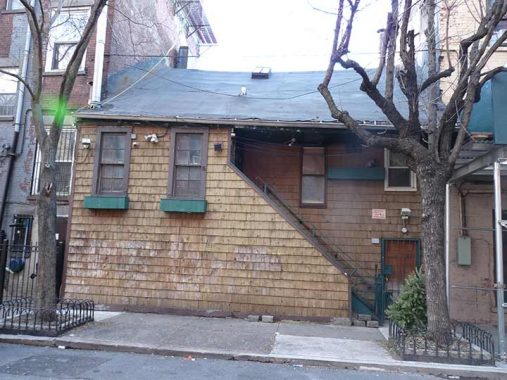
A short lane called Weehawken Street runs between Christopher and West 10th Streets just east of West Street and stands on what, in the colonial era, was on the grounds of the Newgate State Prison. Nearby Charles Lane is a Belgian-blocked alley that used to run along the prison’s north wall.
Newgate Prison stood in the West Village between 1797 and about 1828 at the Hudson River shoreline, bordered by Washington, Christopher and just south of where Perry Street would later appear. Newgate was NY State’s first penitentiary, and pioneered radical correctional policies such as allowing prisoners light in their cells, water to bathe, no corporal punishment, visits from families, and rehabilitational training. By the late 1820s, the prison was no longer isolated and was surrounded by streets and businesses, and transferred to Ossining in Westchester County, the prison known popularly as Sing Sing (land on which the prison was built was called Sintsink by the Indians).
After Newgate’s prisoners were transferred to Sing Sing, NYC reserved the waterfront area between Christopher and Amos (later West 10th) for a public market. Weehawken Street owes its existence to this market, as it was laid out around 1830 to accommodate wagons bringing produce to and from the market, serving the small wholesalers built along its length. Christopher Street was also widened in this area to accommodate the market. Farmers from New Jersey locations — prominently, Weehawken — set up stalls in the market.
Despite its opportune location the Weehawken Market did not successfully compete with the larger Washington Market further downtown (in a plot now occupied by the Independence Plaza Apartments). The market was abandoned in 1844 and plots were sold off to private owners who proceeded to erect a variety of structures on the west side of Weehawken Street. Developers had already been busily constructing buildings on the east side of the street since it was opened in 1830.
Known as both #6 Weehawken and #392 West Street, by many accounts this is the only building left over from the old Weehawken Market and one of the few wood-frame buildings left in Manhattan. It had been in a row of similar buildings that had all been demolished by 1937.
Quoting from the LPC Designation Report (which is almost unnecessarily thorough on the Weehawken Street Historic District; q.v. for many more details on this historic building.
Helen Tangires, in “Public Markets and Civic Culture in Nineteenth-Century America” (2003), described the prototype for this kind of market house:
The simple, freestanding shed was the most prolific type of market house, lending itself well to a street location. It had been a standard form in colonial America… Open or closed, it consisted of arches of stout timber or brick pillars supporting a low-pitched gable roof. Builders occasionally added wide projecting eaves to increase the space for marketing. Sheds provided minimal protection from the elements for the least cost, did not require an architect, and were quick to build…. In addition, the shed’s multiple entrances made the market attractive and accessible to patrons coming from any direction; its openness promoted air circulation and helped in unloading goods; and it was easy to wash down at the end of a market day.
The building is a one-of-a kind example of postcolonial architecture and a reminder of NYC’s maritime legacy.
Want to see more of Weehawken Street? You’ve come to the right place.
As always, “comment…as you see fit.” I earn a small payment when you click on any ad on the site.
11/7/22
